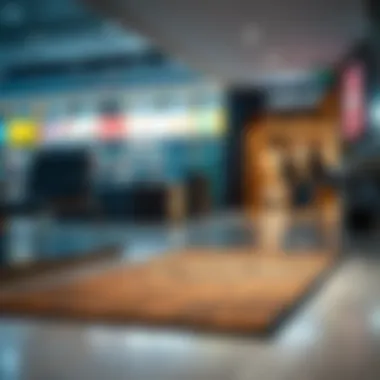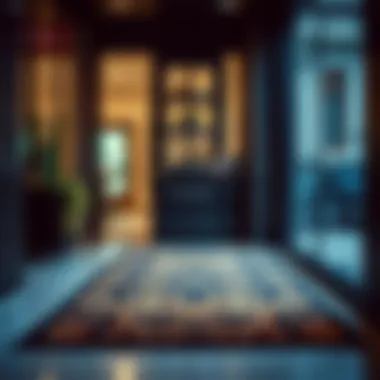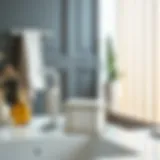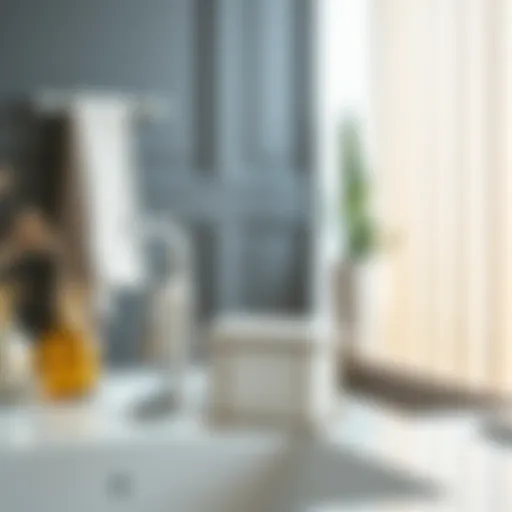The Role and Importance of Shop Entrance Mats


Intro
In today’s fast-paced retail environment, a merchant’s physical space often serves as the first line of communication with potential customers. Shop entrance mats, while often underestimated, play a crucial role in this interaction. They represent more than just a decorative piece that greets customers as they walk in. Entrance mats are a multifaceted element of modern commercial spaces, enhancing safety, cleanliness, and even branding.
From the moment a customer steps through the door, a well-chosen mat can set the tone for their experience. Think about it: a clean, visually appealing mat invites customers to explore further, whereas a worn-out one can say, "we don't pay attention to detail." This article will dive into the practical and aesthetic benefits of shop entrance mats, considering their various types, materials, and designs. Moreover, we'll touch on how these mats contribute to a cohesive branding strategy for shops, helping to strengthen customer loyalty and foster a positive shopping atmosphere.
By the end of this piece, it should be crystal clear why selecting the right shop entrance mat should be on every retailer's to-do list. It doesn't just matter what mat you use, but why it matters and how it affects the overall shopping experience.
So let’s roll up our sleeves and explore what makes these mats not just functional but essential for modern retail spaces.
Understanding Shop Entrance Mats
Shop entrance mats serve as the first line of defense in maintaining a clean and safe retail environment. Often overlooked, their presence in any commercial space is essential for numerous reasons. They act not only as a functional element but as an integral part of the customer experience, significantly impacting perceptions of cleanliness and safety. When customers walk into a shop, the first thing they notice is usually the entrance. A well-maintained entrance mat not only enhances the aesthetic appeal but also serves practical purposes that can avoid bigger issues down the line. From preventing dirt to minimizing accidents, the roles of these mats cannot be understated.
Definition and Purpose
Entrance mats, commonly found at the entry points of shops and businesses, are designed to trap dirt, moisture, and debris from shoes before they enter the premises. Their purpose extends beyond mere flooring options; they provide a barrier that protects interior flooring, maintains hygiene, and significantly reduce the amount of cleaning required. Additionally, these mats can contribute to branding through custom designs and logos, making them a versatile choice for retailers aiming to create a memorable first impression.
Functional Benefits
Entrance mats come with a range of practical advantages that enhance both functionality and safety within a space.
Protection Against Dirt and Moisture
One of the chief roles of entrance mats is to safeguard against dirt and moisture. Each time someone steps through the door, tiny particles of soil, dust, or inherent moisture from wet shoes can wreak havoc on interior flooring. Mats specially designed to absorb water can prevent slippery surfaces that pose a safety hazard.
- Effective Barrier: Entrance mats catch dirt and moisture at the door, significantly keeping the interior clean.
- Material Efficiency: Mats made from durable materials like rubber or coir are particularly effective in this regard because they resist wear and tear, giving them longevity while providing maximum protection.
This means that in areas prone to rain or heavy foot traffic, having the right mat is an investment in both safety and savings on cleaning costs.
Safety and Slip Resistance
Safety goes hand-in-hand with the functionality of shop entrance mats. A well-chosen mat provides crucial slip resistance when the floor is wet, which is often the case during rainy seasons or when snow melts. These mats not only help with prevention but also comply with safety regulations in many commercial settings.
- High Traction: Many entrance mats feature textured surfaces to improve grip, which is paramount in preventing slips or falls, particularly in high-traffic areas or places where spills are likely.
- Preventative Measure: Investing in slip-resistant mats can also lead to fewer accident-related liabilities, protecting the business and its patrons.
Taking these aspects into account, selecting the right shop entrance mat isn’t just about aesthetics or trivial décor; it’s a foundational choice that resonates throughout various operational areas of the business.
Types of Entrance Mats
Entrance mats come in various forms, each tailored to meet specific needs and environments. Understanding the different types is crucial for making an informed choice that aligns with your shop's functional and aesthetic goals. Here, we dive into several significant categories that cater to a wide range of requirements.
Indoor vs. Outdoor Mats
Material Comparisons
When it comes to material comparisons, understanding the nuances of indoor and outdoor mats is vital. Indoor mats usually boast materials like nylon and polyester, known for their resilience and ability to trap dirt without degrading quickly. Conversely, outdoor mats tend to use rubber or coir—these materials are robust, withstand the elements, and resist fading from sunlight.
This distinction impacts not only the durability but also the maintenance routines that may be necessary. For instance, rubber mats can be easily hosed down, while nylon mats might require regular vacuuming, affecting overall cleaning strategies in your business.
Design Variations
The design variations between indoor and outdoor mats are not only about aesthetics but also their functional roles. Indoor mats often have softer, welcoming designs meant to enhance the customer experience. Colors and patterns can be customized to match store branding effectively. Meanwhile, outdoor mats prioritize durability and may come with textured surfaces to enhance grip. Consumers in today's world lean towards unique mats that tell a story about the brand they represent, making this design consideration crucial for branding efforts.
Scraper Mats
Scraper mats are essential for removing dirt and debris right at the entrance. These mats often feature tough, textured surfaces that act like little bouncers for mud, preventing it from entering your store. This proactive approach not only protects your flooring but also reduces cleaning time, allowing staff to focus more on customer interaction than on mopping. These mats are a cornerstone in busy establishments like supermarkets or shopping centers.
Water Absorbent Mats
Water absorbent mats serve a critical necessity in places where weather can be unforgiving. These mats can drastically reduce slip hazards by soaking up moisture from shoes as customers enter. Made from advanced synthetic fibers, water-absorbent mats are designed to hold considerable amounts of water without becoming saturated. This quality is especially vital in regions prone to rainfall or snow, ensuring a safe shopping experience for all.
Custom Logo Mats


Branding and Marketing Impact
Custom logo mats act as a subtle yet effective branding tool. These mats aren't just functional; they serve as a visual indicator of your brand as soon as customers step inside. By integrating logos and colors associated with your business, custom mats create a first impression that can resonate with shoppers. Ensuring that your store's image is front and center can enhance brand recognition and loyalty, creating a significant impact on overall marketing efforts.
Design Options
The design options for custom logo mats are vast and can truly reflect an establishment’s character. From color and size to the complexity of the logo itself, stores can tailor these mats to coordinate with their interior design. A unique mat can be a conversation starter and may even encourage customers to share their experience on social media platforms. However, investing in custom designs means paying attention to quality to prevent premature wear, which can diminish their original intended impact.
"A well-chosen entrance mat is much more than decor—it's the first impression that sticks!"
In summary, understanding the different types of entrance mats is pivotal in crafting a space that not only looks good but functions effectively. With the right choices, they can complement store aesthetics while enhancing safety and brand presence.
Selecting the Right Entrance Mat
Choosing the right entrance mat isn’t just about aesthetics; it's spearheading the first impression that customers get when they enter a space. An effective entrance mat can blend function with style, ensuring that the environment feels welcoming while also serving practical needs. With so many options available, it’s essential to understand the different factors that go into selecting the most appropriate mat for your specific situation.
Identifying Your Needs
Traffic Volume Considerations
Understanding traffic volume is crucial. If your shop sees a constant stream of foot traffic, a mat needs to be durable and resilient. High-traffic areas require mats that can withstand the pressure and wear, maintaining their look and function over time. When choosing your mat, consider its ability to handle the daily grind; a mat that can endure heavy use ensures longevity and cost-effectiveness.
For instance, a commercial space with bustling activity can benefit from a thicker mat that provides stability and a better grip, diminishing the chances of slips and falls during busy hours. It’s apparent that underestimating expected footfall could result in a mat that wears out too quickly—costing businesses more in replacements and possibly leading to accidents, a risk no retailer wants to take.
Climate and Weather Factors
Weather can play a significant role in selecting an entrance mat. Whether your shop is situated in a rain-prone area, a snowy region, or a place with dry heat impacts the materials best suited for entrance mats.
A mat designed for wet environments often features a water-absorbent core that can trap moisture and dirt effectively, keeping the interior dry and safe from slips. Conversely, in arid climates, mats need to withstand dust and grit, combating buildup without compromising cleanliness.
Material Selection
Rubber
Rubber mats are an outstanding option, primarily due to their intrinsic slip-resistant nature and ability to handle moisture effectively. These mats can absorb substantial wear and tear without showing significant signs of damage. The resilience of rubber makes it a popular choice in dynamic retail spaces where foot traffic is high.
One downside to rubber is that it can be heavy, making it less portable for spaces that might require rolling out mats or moving them around regularly. However, its durability often outweighs these concerns, making rubber mats a long-term investment worth considering.
Coir
Coir, sourced from coconut husks, is another excellent option, particularly for outdoor mats. This material is natural and eco-friendly, providing a rustic charm that aligns well with organic store aesthetics. Coir mats are designed to scrape off dirt and grit effectively, making them a solid choice for areas that contend with external elements.
A notable feature of coir is its tendency to lose fibers over time—though it's a natural occurrence, it may not be every retailer’s preference. This is a factor to consider, especially for businesses relying on maintaining a specific clean visual appearance.
Nylon
Nylon mats bring a blend of style and functionality into the mix. Available in various colors and styles, nylon is lightweight yet durable, making it a versatile choice for many shops. These mats are designed to handle moisture and absorbing dirt well, especially helpful in preventing tracking into the store.
One minor drawback is that nylon might not perform as effectively in extreme weather conditions compared to rubber or coir. Still, its aesthetic appeal is hard to beat, making it a favored option for businesses aiming to maintain a polished appearance.
Size and Placement
Measuring Entrances
Measuring entrances thoroughly is critical in selecting the right size for your entrance mat. An ill-fitting mat, whether too small or too large, can hinder functionality and aesthetic value. Ensuring that the mat is properly sized to cover the entrance enables it to perform its duty efficiently—catching dirt and trapping water effectively.
Precise measurements can help in selecting a mat that fits snugly under doors without causing obstructions. A well-measured mat can also contribute to a cleaner environment, as dirt is less likely to make its way inside if the mat is positioned correctly.
Strategic Placement Tips
Placement of the mats matters just as much as selecting the right size. A strategically placed mat at the entrance can be effective in not only controlling soil and water but also enhancing your space's overall aesthetic. It’s wise to position mats where they naturally align with customer footpaths, ensuring seamless transitions from outside to inside.


Opt for mats that overlap into interior spaces slightly, making it necessary for step-ups onto the mat. This will solve the issue of people forgetting to wipe their feet, keeping the floor cleaner and safer overall. A well-placed mat adds to the welcoming feel of a shop, providing both function and form, embodying the essence of what a good entrance mat should achieve.
The Aesthetic Role of Entrance Mats
The aesthetic role of entrance mats extends far beyond mere functionality; they serve as the first impression for any shop or establishment. Entrance mats are the unsung heroes of customer experience. With thoughtful design choices, they can significantly enhance the ambiance of a space, making it feel more inviting and cohesive. Here’s a deeper dive into their aesthetic contributions, starting with how they align with broader store design.
Complementing Store Design
Color Coordination
Color coordination plays a crucial part in creating a harmonious environment. When entrance mats are selected to match or complement the color scheme of a store, they create a seamless transition from the exterior to the interior. This technique can strengthen brand identity and enhance customer perception.
One key characteristic of color coordination is that it allows businesses to reinforce their brand voice. For example, a shop with a modern vibe may opt for mats in sleek blacks or whites, while a cozy café might lean towards softer, earthy tones. This alignment makes the whole shopping experience feel more curated. In terms of advantages, color-coordinated mats can also hide dirt and stains better than lighter colors, combining aesthetics with practicality.
One potential disadvantage is that not every color will resonate positively with every customer base. Business owners need to think critically about their target audience's preferences, ensuring that the colors chosen do spark joy or comfort rather than feeling out of place.
Pattern Selection
Moving on to pattern selection, this aspect of aesthetic design allows for a bit more creativity. Patterns can act as visual cues that direct customers towards the entrance or lead them into specific areas within a shop. The right pattern can add character and flair, acting almost as a piece of artwork on the ground.
A distinguished feature of patterns is their ability to express individuality. Unique geometric designs can speak to a modern, elegant store, while playful patterns might work well for stores aimed at children or particular niches. The advantages of using distinctive patterns are manifold; they can provoke interest and engage customers right from the threshold. However, it’s crucial to strike a balance. Overly complicated designs may detract from the products being sold or give an impression of clutter, which might turn off potential buyers.
Creating a Welcoming Atmosphere
Creating a welcoming atmosphere is yet another significant role played by entrance mats. The sight of a clean, well-designed mat can signal to customers that the business cares about details, which translates into better service. This aspect goes beyond aesthetics; it relates to customer psychology. A welcoming mat not only invites people to step inside but also assures them that they've entered a well-maintained environment.
In a sense, entrance mats serve not just a practical purpose but a pioneering one in setting the tone. Whether it be through innovative designs or careful placement, their aesthetic impact is undeniable. For homeowners and commercial retailers alike, understanding the role these mats play can lead to choices that not only protect floors but elevate the overall shopping experience.
Maintaining Shop Entrance Mats
Maintaining shop entrance mats is crucial in ensuring their longevity and effectiveness within commercial environments. The entrance mat serves not only a functional role—protecting interiors from dirt and moisture—but also contributes to aesthetics and safety. When mats are well-kept, they not only enhance the look of the space but also prevent accidents caused by slick or dirty surfaces, thus promoting a better experience for customers and staff alike.
Routine Cleaning Practices
Vacuuming Techniques
Routine vacuuming is an essential practice for maintaining shop entrance mats. It removes loose dirt and debris that can accumulate over time. The key benefit of vacuuming is its efficiency; it's quick to perform and can be integrated into daily cleaning routines without much added effort. Regular vacuuming can prevent wear and tear on materials, prolonging the life of the mats.
One unique feature of efficient vacuuming techniques is the use of vacuums equipped with rotating brushes. These brushes agitate the fibers, allowing for a deeper clean than standard suction alone. This results in better dirt removal, especially on mats that have textures that trap particles. However, not all mats are suited for heavy brushing. For delicate materials, a standard flat vacuum head is recommended to avoid causing damage.
- Advantages of Vacuuming:
- Disadvantages:
- Quick and effective for surface dirt
- Prevents buildup of grime, prolonging mat life
- Easily incorporated into daily cleaning tasks
- Might not remove deeper stains or odors
- Requires regularity to maintain effectiveness
Deep Cleaning Methods
Deep cleaning methods are necessary for mats that have faced significant wear or have accumulated heavy stains. Unlike routine vacuuming, deep cleaning involves using specialized equipment or cleaning solutions to thoroughly cleanse the mat fibers. This method can rejuvenate mats, restoring their appearance and functionality.
A key characteristic of deep cleaning is the use of hot water extraction, often referred to as steam cleaning. This technique not only cleans the mat but also sanitizes it, removing allergens and bacteria that could pose health risks. This kind of deep clean can be beneficial in high-traffic areas where germs may linger.
However, deep cleaning requires more time and proper drying practices to avoid moisture retention that can lead to mold and mildew on mats. It’s important to note that deep cleaning frequency should be based on usage; mats in busy establishments may need this treatment more often.
- Advantages of Deep Cleaning:
- Disadvantages:
- Thoroughly removes dirt and odors
- Sanitizes, improving hygiene in the space
- Enhances overall appearance
- More time-consuming than vacuuming
- May require trained personnel and equipment
Signs of Wear and Replacement


Observing and identifying signs of wear is a vital aspect of mat maintenance. Common indicators that an entrance mat needs replacement include frayed edges, visible holes, or significant discoloration. When mats start showing signs of damage, they become less effective at trapping dirt and moisture.
For merchant retailers and shop owners, recognizing these signs early can prevent unsightly and unsafe conditions. Regular inspections should be a part of the maintenance routine, especially after seasons of severe weather, which can expedite wear. If a mat looks more tattered than tidy, it’s probably time for a new one. Investing in quality mats and proper maintenance practices ensures safety, cleanliness, and enhances the overall image of the establishment.
Environmental Considerations
In today’s world, the conversation around sustainability is more pressing than ever. Environmental considerations in the selection and use of shop entrance mats are crucial not just for the planet but also for businesses. Integrating eco-friendly practices can enhance a brand's reputation and attract conscientious customers. Here’s a look at some significant elements and benefits regarding environmental considerations of entrance mats.
Eco-Friendly Material Options
Choosing the right material for entrance mats can greatly affect their environmental impact. Look for options made from recycled or sustainable materials. Here are some popular eco-friendly choices:
- Rubber: Natural rubber mats are durable and recyclable. They often come from sustainably harvested sources and are long-lasting, reducing the need for frequent replacements.
- Coir: This material, derived from the husks of coconuts, is biodegradable and sustainable. Coir mats are excellent at trapping dirt and moisture, making them perfect for entrance areas.
- Nylon: While conventional nylon is derived from petrochemicals, some companies have begun to produce nylon mats from recycled materials, thus minimizing the overall environmental footprint.
These materials help mitigate waste and contribute to a healthier environment. By opting for eco-friendly mats, businesses not only fulfill their responsibility towards the earth but also showcase their dedication to sustainable practices.
Sustainable Production Practices
Beyond the materials, the production process of entrance mats also holds environmental significance. Engaging in sustainable production practices can lead to lower ecological impact.
It’s worth considering the following aspects when evaluating manufacturers:
- Waste Reduction: Select manufacturers that prioritize minimizing waste during production. Techniques such as upcycling scraps from other processes can turn potential waste into valuable resources.
- Energy Efficiency: Some companies invest in energy-efficient machinery and renewable energy sources to power their production lines. This not only lowers carbon emissions but also encourages a greener industry overall.
- Certification: Look for certifications indicating adherence to environmental standards. Certifications such as ISO 14001 can signal that a manufacturer is committed to effective environmental management.
Incorporating these sustainable practices elevates the potential of entrance mats beyond basic functionality; it aligns them with a broader commitment to the planet—a consideration that increasingly matters to consumers today.
“Making thoughtful choices about what goes in your shop isn’t just smart for business; it’s crucial for our shared future.”
When integrated into the broader strategy of retail operations, these eco-friendly materials and sustainable practices can significantly enhance corporate responsibility while also appealing to a growing segment of environmentally-conscious customers. Understanding these considerations can fortify a shop's role in promoting sustainability, reaffirming our shared obligation to protect the environment while providing quality products.
Case Studies: Effective Use of Entrance Mats
Case studies illuminate the practicality and advantages of shop entrance mats in real-world scenarios. By examining specific implementations across various sectors, the significance of these mats becomes crystal clear. They serve not only as a first line of defense against dirt and moisture but also play a crucial role in enhancing the overall shopping experience, safety, and brand image. Here, we’ll delve into successful applications in retail and hospitality, showcasing how the right entrance mats can transform spaces.
Retail Store Success Stories
In the retail sector, first impressions are paramount. Entrance mats act as silent sentinels, protecting businesses from dirt while promoting an inviting atmosphere. One noteworthy example is The Home Depot. This retail giant utilizes commercial-grade scraper mats at its entrances. These mats are designed to capture dirt and moisture from customers' shoes effectively. By strategically placing these mats, Home Depot minimizes the amount of debris tracked indoors, which helps maintain cleanliness and prolongs the life of flooring.
Not only do these entrance mats serve a functional purpose, but they also bolster safety. By reducing the chances of slipping, especially during rainy season, the mats created a safer environment for customers and employees alike. At the same time, they incorporate branding by featuring the company logo, which reinforces the brand identity right at the entrance.
"A retail store's entrance is like a handshake; clean and welcoming sets the tone for the entire experience."
Another success story includes Nike. The sportswear retailer employs custom logo mats at flagship locations, aligning branding with functionality. These mats not only enhance visual appeal but also capture dirt and moisture, protecting sleek, polished floors typical of high-end retail environments. This strategic investment highlights the balance between aesthetics and practical use.
Hospitality Industry Applications
The hospitality industry operates at the intersection of comfort and cleanliness, making entrance mats indispensable. A compelling case can be seen at The Ritz-Carlton hotels. They employ plush, absorbent entrance mats that not only trap moisture but also add a touch of luxury. The mats are integrated into the overall elegant design of their lobbies, subtly enhancing guest perceptions during arrival.
At these establishments, the mats contribute to an overall impression of cleanliness and attention to detail. Moreover, they are periodically replaced to ensure that they reflect the high standards the Ritz-Carlton is known for. This is critical in reinforcing a positive customer experience from the moment guests step inside.
Another example can be drawn from Hilton Hotels, which utilizes anti-slip entrance mats in busy locations. These mats are strategically placed to avoid accidents, especially in high-traffic areas. By addressing safety concerns upfront, Hilton demonstrates commitment to guest welfare, creating an environment where patrons can feel secure and attended to.
Closure: The Lasting Impact of Shop Entrance Mats
Understanding the Value of Entrance Mats
From the moment a customer steps into a store, their experience begins to unfold. Shop entrance mats play a crucial role in shaping this initial impression. They are not merely functional; they serve as a vital element in the retail environment, affecting both aesthetics and safety. Through their varied designs and materials, entrance mats protect interiors, create a welcoming atmosphere, and reinforce a brand's identity.
The significance of shop entrance mats transcends their basic utility; they are integral to customer experience and operational efficiency.
Recap of Key Points
Before diving into future trends, let’s recap the essential aspects discussed in this article:
- Functional Benefits: Entrance mats provide protection against dirt, moisture, and create a safer environment. They reduce slip hazards, enhancing safety for both customers and employees.
- Diverse Types: Various mats serve distinct purposes—scraper mats for removing dirt, water absorbent mats for moisture management, and custom logo mats for branding. Each type offers unique advantages tailored to specific retail needs.
- Selecting the Right Mat: It’s important to assess the volume of foot traffic and local weather when choosing an entrance mat. This ensures longevity and effectiveness in function.
- Maintenance and Care: Regular cleaning and being vigilant for signs of wear can significantly prolong the lifespan of entrance mats.
- Environmental Concerns: Going green is not just a trend but a necessity. More businesses focus on eco-friendly materials and sustainable practices in mat production, aligning with broader environmental goals.
Future Trends in Entrance Mats
Looking ahead, several developments in the world of entrance mats are worth noting.
- Smart Mats: Technology is making its debut in the mat realm. With smart features, future mats could monitor foot traffic, alerting store owners to cleaning needs or possible safety issues in real-time.
- Sustainable Materials: As consumers become more environmentally conscious, expect a surge in mats made from recycled materials. This aligns with the growing demand for sustainable products across industries.
- Increased Customization: More retailers are expected to invest in custom designs that reflect their brand image, utilizing unique patterns and colors that resonate with their audience.
- Health and Safety Features: With the rise in health awareness, mats that incorporate antimicrobial properties could become standard, ensuring even greater safety for customers and staff.















